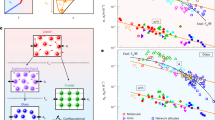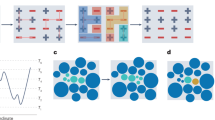Abstract
A fundamental understanding of the glass transition is essential for enabling future breakthroughs in glass science and technology. In this paper, we review recent advances in the modeling of glass transition range behavior based on the enthalpy landscape approach. We also give an overview of new simulation techniques for implementation of enthalpy landscape models, including techniques for mapping the landscape and computing the long-time dynamics of the system. When combined with these new computational techniques, the enthalpy landscape approach can provide for the predictive modeling of glass transition and relaxation behavior on a laboratory time scale. We also discuss new insights from the enthalpy landscape approach into the nature of the supercooled liquid and glassy states. In particular, the enthalpy landscape approach provides for natural resolutions of both the Kauzmann paradox and the question of residual entropy of glass at absolute zero. We further show that the glassy state cannot be described in terms of a mixture of equilibrium liquid states, indicating that there is no microscopic basis for the concept of a fictive temperature distribution and that the glass and liquid are two fundamentally different states. We also discuss the connection between supercooled liquid fragility and the ideal glass transition.
Similar content being viewed by others
References
Tait H.: Five Thousand Years of Glass. British Museum Press, London (1991)
Zanotto E.D., Gupta P.K.: Do cathedral glasses flow?—additional remarks. Am. J. Phys. 67(3), 260–262 (1999)
Gupta P.K., Mauro J.C.: The laboratory glass transition. J. Chem. Phys. 126(22), 224504 (2007)
Tool A.Q.: Relation between inelastic deformability and thermal expansion of glass in its annealing range. J. Am. Ceram. Soc. 29(9), 240–253 (1946)
Narayanaswamy O.S.: A model of structural relaxation in glass. J. Am. Ceram. Soc. 54(10), 491–498 (1971)
Turnbull D., Cohen M.H.: On the free-volume model of the liquid-glass transition. J. Chem. Phys. 52(6), 3038–3041 (1970)
Cohen M.H., Grest G.S.: Liquid-glass transition, a free-volume approach. Phys. Rev. B 20(3), 1077–1098 (1979)
Gupta P.K.: Models of the glass transition. Rev. Solid State Sci. 3(3–4), 221–257 (1989)
Gibbs J.H., DiMarzio E.A.: Nature of the glass transition and the glassy state. J. Chem. Phys. 28(3), 373–383 (1958)
Leutheusser E.: Dynamical model of the liquid-glass transition. Phys. Rev. A 29(5), 2765–2773 (1984)
Bengtzelius U., Götze W., Sjölander A.: Dynamics of supercooled liquids and the glass transition. J. Phys. C: Solid State Phys. 17(33), 5915–5934 (1984)
Debenedetti P.G.: Metastable Liquids: Concepts and Principles. Princeton University, Princeton (1996)
Kob W.: Computer simulation of supercooled liquids and glasses. J. Phys.: Condens. Matter 11(10), R85–R115 (1999)
Scherer G.W.: Relaxation in Glass and Composites. Wiley, New York (1986)
Jäckle J.: Models of the glass transition. Rep. Prog. Phys. 49(2), 171–231 (1986)
Varshneya A.K.: Fundamentals of Inorganic Glasses, 2nd edn. Society of Glass Technology, Sunderland (2007)
Gupta P.K.: Non-crystalline solids: glasses and amorphous solids. J. Non-Cryst. Solids 195(1–2), 158–164 (1996)
Goldstein M.: Viscous liquids and the glass transition: a potential energy barrier picture. J. Chem. Phys. 51(9), 3728–3739 (1969)
Stillinger F.H., Weber T.A.: Hidden structure in liquids. Phys. Rev. A 25(2), 978–989 (1982)
Stillinger F.H., Weber T.A.: Dynamics of structural transitions in liquids. Phys. Rev. A 28(4), 2408–2416 (1983)
Stillinger F.H.: Supercooled liquids, glass transitions, and the Kauzmann paradox. J. Chem. Phys. 88(12), 7818–7825 (1988)
Debenedetti P.G., Stillinger F.H., Truskett T.M., Roberts C.J.: The equation of state of an energy landscape. J. Phys. Chem. B 103(35), 7390–7397 (1999)
Debenedetti P.G., Stillinger F.H.: Supercooled liquids and the glass transition. Nature 410(6825), 259–267 (2001)
Stillinger F.H., Debenedetti P.G.: Energy landscape diversity and supercooled liquid properties. J. Chem. Phys. 116(8), 3353–3361 (2002)
Massen C.P., Doye J.P.K.: Power-law distributions for the areas of the basins of attraction on a potential energy landscape. Phys. Rev. E 75, 037101 (2007)
Mauro J.C., Varshneya A.K.: A nonequilibrium statistical mechanical model of structural relaxation in glass. J. Am. Ceram. Soc. 89(3), 1091–1094 (2006)
Zwanzig R.: Nonequilibrium Statistical Mechanics. Oxford University, New York (2001)
Mauro J.C., Loucks R.J., Gupta P.K.: Metabasin approach for computing the master equation dynamics of systems with broken ergodicity. J. Phys. Chem. A 111, 7957–7965 (2007)
Wales D.J.: Energy Landscapes. Cambridge University, Cambridge (2003)
Middleton T.F., Wales D.J.: Energy landscapes of model glasses. II. Results for constant pressure. J. Chem. Phys. 118(10), 4583–4593 (2003)
Mauro J.C., Loucks R.J., Balakrishnan J.: Split-step eigenvector-following technique for exploring enthalpy landscapes at absolute zero. J. Phys. Chem. B 110(10), 5005–5011 (2006)
Mauro J.C., Loucks R.J., Balakrishnan J.: A simplified eigenvector-following technique for locating transition points in an energy landscape. J. Phys. Chem. A 109(42), 9578–9583 (2005)
Wang F., Landau D.P.: Determining the density of states for classical statistical models: a random walk algorithm to produce a flat histogram. Phys. Rev. E 64, 056101 (2001)
Mauro J.C., Loucks R.J., Balakrishnan J., Raghavan S.: Monte Carlo method for computing density of states and quench probability of potential energy and enthalpy landscapes. J. Chem. Phys. 126, 194103 (2007)
Mauro J.C., Loucks R.J.: Selenium glass transition: a model based on the enthalpy landscape approach and nonequilibrium statistical mechanics. Phys. Rev. B 76, 174202 (2007)
Moynihan C.T., Easteal A.J., DeBolt M.A., Tucker J.: Dependence of the fictive temperature of glass on cooling rate. J. Am. Ceram. Soc. 59(1–2), 12–16 (1976)
Mauro J.C., Varshneya A.K.: Model interaction potentials for selenium from ab initio molecular simulations. Phys. Rev. B 71, 214105 (2005)
Sreeram A.N., Varshneya A.K., Swiler D.R.: Molar volume and elastic properties of multicomponent chalcogenide glasses. J. Non-Cryst. Solids 128(3), 294–309 (1991)
Senapati U., Varshneya A.K.: Viscosity of chalcogenide glass-forming liquids: an anomaly in the ‘strong’ and ‘fragile’ classification. J. Non-Cryst. Solids 197(2–3), 210–218 (1996)
Palmer R.G.: Broken ergodicity. Adv. Phys. 31(6), 669–735 (1982)
Goldstein S., Lebowitz J.L.: On the (Boltzmann) entropy of non-equilibrium systems. Physica D 193(1–4), 53–66 (2004)
Speedy R.J.: The entropy of glass. Mol. Phys. 80(5), 1105–1120 (1993)
Jäckle J.: On the glass transition and the residual entropy of glasses. Philos. Mag. B 44(5), 533–545 (1981)
Mauro J.C., Gupta P.K., Loucks R.J.: Continuously broken ergodicity. J. Chem. Phys. 126, 184511 (2007)
Lebowitz J.L.: Microscopic origins of irreversible macroscopic behavior. Physica A 263, 516–527 (1999)
Lebowitz J.L.: Statistical mechanics: a selective review of two central issues. Rev. Mod. Phys. 71(2), S346–S357 (1999)
Kivelson D., Reiss H.: Metastable systems in thermodynamics: consequences, role of constraints. J. Phys. Chem. B 103, 8337–8343 (1999)
Angell C.A.: Spectroscopy simulation and scattering, and the medium range order problem in glass. J. Non-Cryst. Solids 73(1–3), 1–17 (1985)
Angell C.A.: Structural instability and relaxation in liquid and glassy phases. J. Non-Cryst. Solids 102(1–3), 205–221 (1988)
Angell C.A.: Relaxation in liquids, polymers and plastic crystals—strong/fragile patterns and problems. J. Non-Cryst. Solids 131–133(1), 13–31 (1991)
Angell C.A., Ngai K.L., McKenna G.B., McMillan P.F., Martin S.W.: Relaxation in glassforming liquids and amorphous solids. J. Appl. Phys. 88(6), 3113–3157 (2000)
Angell C.A.: Liquid fragility and the glass transition in water and aqueous solutions. Chem. Rev. 102, 2627–2650 (2002)
Kauzmann W.: The nature of the glassy state and the behavior of liquids at low temperatures. Chem. Rev. 43, 219–256 (1948)
Huang D., Simon S.L., McKenna G.B.: Equilibrium heat capacity of the glass-forming poly (α-methyl styrene) far below the Kauzmann temperature: the case of the missing glass transition. J. Chem. Phys. 119(7), 3590–3593 (2003)
Stillinger F.H., Debenedetti P.G., Truskett T.M.: The Kauzmann paradox revisited. J. Phys. Chem. B 105(47), 11809–11816 (2001)
Stillinger F.H., Debenedetti P.G.: Phase transitions, Kauzmann curves, and inverse melting. Biophys. Chem. 105(2), 211–220 (2003)
Tool A.Q., Eichlin C.G.: Variations caused in the heating curves of glass by heat treatment. J. Am. Ceram. Soc. 14, 276–308 (1931)
Ritland H.N.: Limitations of the fictive temperature concept. J. Am. Ceram. Soc. 39(12), 403–406 (1956)
Giovambattista N., Stanley H.E., Sciortino F.: Cooling rate, heating rate, and aging effects in glassy water. Phys. Rev. E 69, 050201(R) (2004)
Lubchenko V., Wolynes P.G.: Theory of aging in structural glasses. J. Chem. Phys. 121(7), 2852–2865 (2004)
Mauro, J.C., Loucks, R.J., Gupta, P.K.: Fictive temperature and the glassy state. Phys. Rev. E. (2008, submitted)
Author information
Authors and Affiliations
Corresponding author
Additional information
In loving memory of Salvatore M. Mauro. “Give a man a fish and he will eat for a day. Teach him how to fish and he will eat for a lifetime.”
Rights and permissions
About this article
Cite this article
Mauro, J.C., Loucks, R.J., Varshneya, A.K. et al. Enthalpy landscapes and the glass transition. Sci Model Simul 15, 241–281 (2008). https://doi.org/10.1007/s10820-008-9092-2
Received:
Accepted:
Published:
Issue Date:
DOI: https://doi.org/10.1007/s10820-008-9092-2




